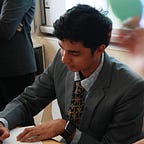The Paradox of Consciousness and Personal Identity.
AUTHOR’S NOTE: — This blog is in continuation with the previous blogpost. Please give that a read before coming to this post. — The Paradox of Consciousness and Mind Digitization.
“The brain weighs only 3 pounds, and yet it is the most complex object in the solar system.” — Michio Kaku
Personal identity is the unique numerical identity of a person in space and time. That is, the necessary conditions to determine whether a person at two different times are the same person. Consciousness, on the other hand, is intrapersonal. According to some physicists, it is the sum total of all feedback loops occurring within our brain in order to create a model of ourselves in space, society and time.
Now, throughout the process of capturing and digitizing your connectome and the rest of your mind, you will be conscious. But, once your mind has been digitized, you will be uploaded. This will cause a break in consciousness. It is like going to sleep on the couch and waking up in a completely simulated environment. This is a problem that has been discussed multiple times in publications and research.
THE CONTINUITY IN CONSCIOUSNESS PROBLEM
Imagine if you stepped into a mind uploader and you woke up in a virtual, simulated world. Will you still be you? Or would it be a virtual copy of you? According to Spatial Tracking, we can determine if you are yourself by drawing a line behind everywhere you go. This would not be possible if you were uploaded. That means you are essentially dead. And the virtual consciousness is a different entity merely resembling you.
Think of it this way, Imagine you are at a party and you took a drug that would make you forget your actions over the next few hours. You will have no recollection of the party. The person at the party and the person waking up tomorrow could essentially be 2 different people.
So in order to achieve seamless upload, continuity of consciousness will need to be maintained.
Now, if a seamlessly uploading machine is made, and continuity of consciousness is achieved, it would mean that a whole bunch of consciousness machines running together would create a virtual world. With virtual consciences interacting together. Hypothetically, if this is possible then the possibility that we are all living in a simulation is highly probable and realistically implementable.
MORAVEC UPLOAD
Hans Moravec proposed another method for mind upload. This time theoretically preserving continuity in consciousness. A brief description of the Moravec procedure is, a scientist injects himself with nano-machines that enter his brain and substitute his neurons one-by-one. After a neuron has been substituted, the functioning of that neuron is copied (uploaded) on a computer; and after each neuron has been copied/uploaded the nano-machines shut down, and the scientist’s body falls on the ground completely limp. Finally, the scientist wakes up inside the computer.
However, it still won’t guarantee if the virtual consciousness is still you. In essence, you have destroyed one thing and made a replica somewhere else.
THE CONNECTOME
If the method described in my previous blog is employed, there is a chance that seamless upload could be achieved. Restoring memories in a replicated brain, digital or otherwise, could in-fact help to restore consciousness. However, the technology required is extremely advanced and still way off into the future for our generation.
Some promising research does provide hope for such a phenomenon to exist.
In 2014, a collective called the OpenWorm project mapped all the connections between a worm’s 302 neurons and managed to simulate them in software. The goal of the project was to completely replicate a worm as a virtual organism. But as an amazing starting point, they managed to simulate its brain, and then they uploaded that into a simple Lego robot.
The idea of existing virtually as an immortal emulation is a huge step towards the symbiosis of humankind with AI. It may also be the next step in the human evolution cycle.
Whole Brain Emulation would enormously expand our capabilities and experiences. A network of your consciousness would be able to compute multiple parallel tasks with equal capacity. It won’t be human. But, if managed correctly, it would still be you.
Thank you for reading :) Please subscribe for more such articles and follow me on Instagram, Medium and GitHub.
